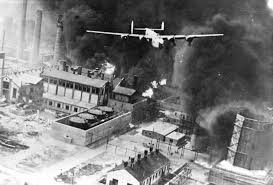🎯 Strategic Bombing Targets the Heart of Oil Infrastructure
By the later years of World War II, the Allies had uncovered one of the most effective paths to victory—not just by defeating enemy armies on the battlefield, but by choking off their fuel at the source. This led to the rise of strategic bombing campaigns specifically aimed at crippling oil infrastructure. The logic was ruthless but sound: without oil, the Axis war machine—its tanks, aircraft, and naval fleets—would grind to a halt. From the skies over Romania to the industrial zones of Nazi Germany, Allied bombers took aim not at soldiers, but at the refineries, synthetic fuel plants, and depots that kept Hitler’s armies in motion. It was a war not just of weapons, but of supply—and oil was the most vital weapon of all.

🛢️ Operation Tidal Wave: The Ploiești Raids
The most dramatic example came in Romania, home to the Ploiești oil fields, which provided nearly a third of Nazi Germany’s fuel in the early war years.
On August 1, 1943, the U.S. Army Air Forces launched Operation Tidal Wave—one of the most daring and costly air raids of the war. 177 B-24 Liberators flew from North Africa on a low-altitude mission to strike the refineries at Ploiești. They came in fast and low, skimming treetops to avoid radar.
But the Germans were ready.
Anti-aircraft fire turned the skies into a hellstorm. Oil tanks erupted into fireballs. Smoke blackened the sky. Though the raid damaged several refineries, the cost was staggering: more than 50 aircraft lost, and hundreds of airmen killed or captured.
Still, the message was clear—oil was now a legitimate military target, and the Allies would stop at nothing to disrupt Axis fuel supplies.
🔥 The POL Campaign: Hitting Germany’s Heart
By 1944, Allied air strategy had evolved into a full-scale assault on what was called POL—Petroleum, Oil, and Lubricants infrastructure. American and British bombers took aim at Germany’s synthetic fuel plants, oil refineries, and storage depots, many located deep within the Reich.
Facilities at Leuna, Böhlen, and Hamburg were pounded relentlessly. The goal was simple: cripple the Nazi war machine by drying up its fuel lines. And it worked.
By the summer of 1944, Germany’s fuel production had plummeted by over 90%. The Luftwaffe, once a dominant force, was grounded. Tanks were abandoned. Panzer divisions lacked the fuel to launch meaningful counterattacks during the Battle of the Bulge.
Hitler had the weapons—but without oil, he couldn’t move them.
⛽ The Human Cost and the Strategic Payoff
These bombing campaigns weren’t without sacrifice. Crews faced withering flak and deadly fighter resistance. Losses were high. Missions were long and grueling.
But the effect on the battlefield was profound. Every bomb dropped on a refinery meant fewer German tanks at the front. Every burning fuel depot meant fewer enemy planes in the sky.
For the first time in military history, energy infrastructure had become a primary battlefield—and the Allies had mastered the art of energy denial.
🔚 Lessons in Smoke and Flame
The strategic bombing of oil infrastructure during World War II redefined military doctrine. It showed that controlling or destroying fuel sources could be as decisive as winning a tank battle or seizing a city.
It also served as a grim preview of wars to come—where oil fields, refineries, and pipelines would not only be sources of wealth, but targets of war.
